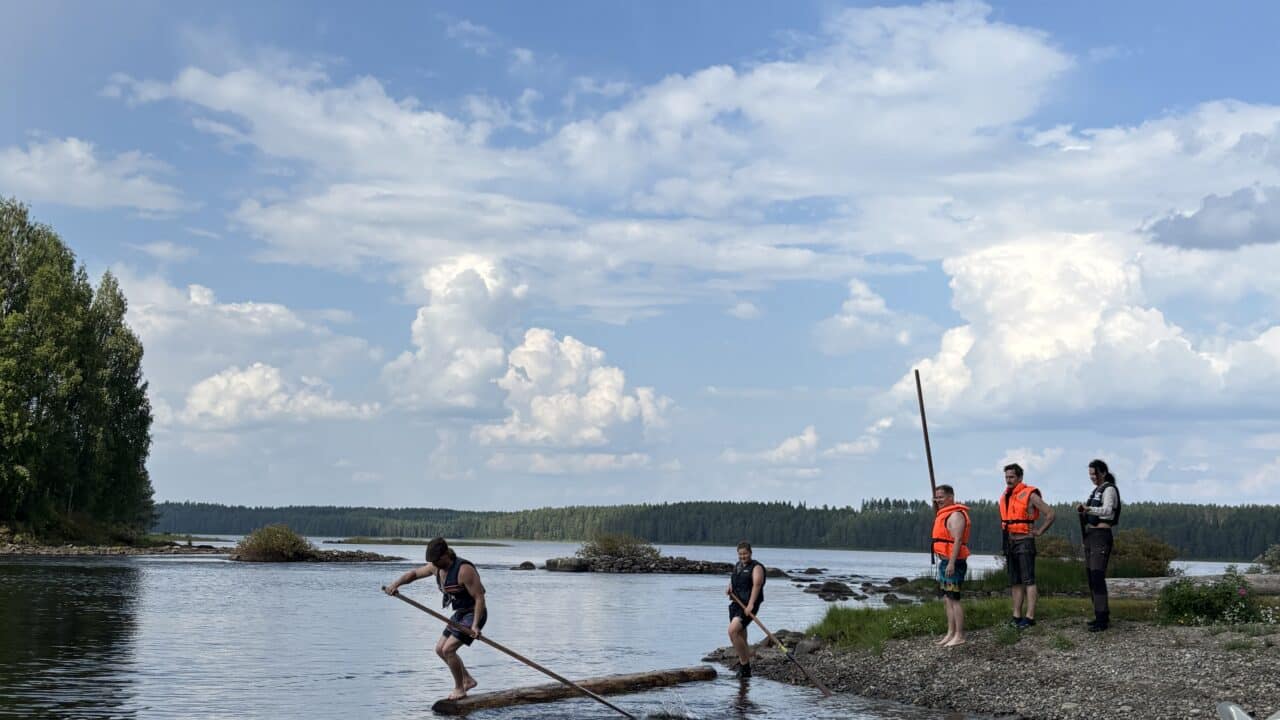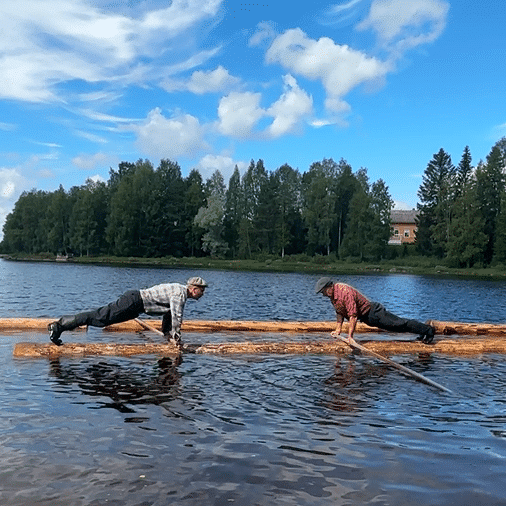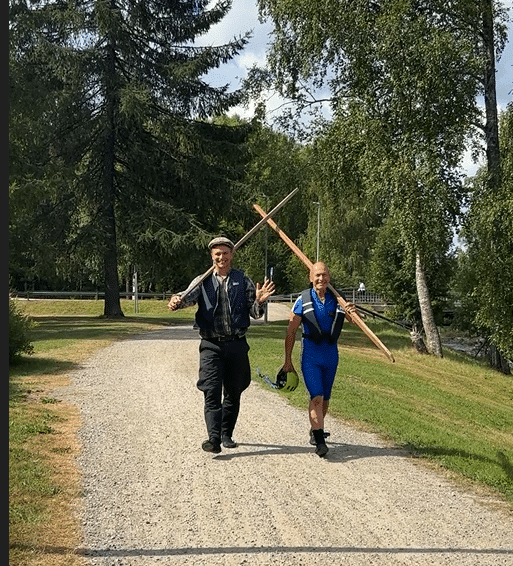Log Driving and Log Drivers
The article deals with the tradition of log driving and the life of log drivers, exploring their history, cultural significance, and events related to the log driving tradition.

Vocabulary Used in Log Driving:
Uitto – Log Driving / Timber Floating
Pomoherra – Foreman, responsible for supervising work and also paying wages.
Kymppi – The foreman’s assistant, in charge of about ten log drivers.
Vonkamies – A log driver who, in tricky spots, oversaw the flow of logs and repaired log-driving equipment, ensuring that the logs “floated smoothly” without piling up.
Tukkijätkä – A northern Finnish term for a log driver (literally “log lad”).
Lentojätkä – A homeless drifter who appeared at log-driving sites in spring.
Tahkojalka – A log driver who can’t stay standing on a floating log.
Ränni – A “chute” or “sluiceway” used to guide logs past steep, winding rapids, waterfalls, mills, or other waterworks. Also used as a term for a separation lane or log jam area.
Historical Background of the Tradition
Log Driving Brought Work
Before industrial forestry, logs were transported via waterways primarily for use in building houses. Log driving continued when the wood-processing industry began to develop in Finland. Forestry and log-driving work provided employment and income for many rural communities throughout the country.
The log-driving tradition was a key factor in the development of Finland’s forest industry, and its effects can still be seen today. This is why the first forest industry plants were built along major waterways, enabling the transport of timber.
In Finland, timber for water-powered sawmills was obtained from the upper reaches of rivers by log driving. Trees felled in winter were hauled by horse to the water’s edge. Once the waters opened in spring, the logs stored near the headwaters were floated downstream and gathered into larger rafts, which were then towed to their destinations—usually as part of cooperative drives.
In cooperative drives, all log drivers working along a river or lake pooled their timber according to agreed arrangements. Efficiency was improved by bundling the logs, after which the bundles were towed to sorting sites or directly to mills. At the sorting sites, logs from different owners were separated according to their log marks, which had been stamped on the ends of the logs. The execution of log drives was planned by water area according to log-driving regulations.
Development of the Forest Industry
In the early days, towing logs involved keluvene (towboats) or ponttu (rafts). On these rafts, an anchor rope was wound around a log either manually or with the help of a horse. First, the anchor was taken farther out, and then the raft, attached by a towline, was pulled toward it. Once the raft reached the anchor, the anchor was moved to a new position. When motorboats became available, towing turned into mechanized work.
Although forestry has largely been mechanized and transport is now often done by trucks and trains, bundle log driving is still used for long-distance transport due to its cost efficiency. A single log raft can carry the equivalent of up to 400 truckloads of timber.

Log Driving Tradition Today
In Finland, the log-driving tradition lives on through associations and enthusiasts. Although the skills of the log drivers are no longer needed for the traditional way for earning a living, practicing and mastering them has become a performance-based hobby, centered on testing the log drivers’ own skills and strength at the sport.
The skills of the log driver and the culture surrounding them reflect traits common to many other traditional hobbies. At a log-driving camp, one can clearly see that cheerfulness and charisma are an essential part of log-driver behavior and attitude. Knowing traditional songs by heart, whistling, and maintaining a generally joyful atmosphere are part of the log-driving spirit. Gentlemanly manners and a lively, outgoing nature are also a distinctive part of a log driver’s reputation.
During a log-driving performance, as participants nimbly hop and dance on floating logs, familiar finish tunes can be heard from their lips, including Jätkän lauantai and the Säkkijärvi polka.
International Connections
The Finnish Log Driving Tradition Association and the Pielinen-Karelia Log Driving Tradition Association participate in international log-driving activities through the International Timber-Raftsmen Association. This European organization has members from over 20 countries.
UNESCO
Spain, Germany, Latvia, Poland, Austria, and the Czech Republic jointly nominated the log-driving tradition for inclusion in UNESCO’s Representative List of the Intangible Cultural Heritage of Humanity, and log driving was inscribed on the list on December 1, 2022.
Intangible Cultural Heritage
The log-driving tradition and log-driving competitions are part of intangible cultural heritage. Intangible cultural heritage consists of living traditions that are present in people’s everyday lives as well as in celebrations.

Log Driving Events
The log-driving tradition is often showcased at various village events across Finland. However, the most important annual log-driving event is held here in Kuhmo.
Finnish Championships in Log Driving Skills!
Alongside the competition, there is a log-driving festival featuring a variety of activities and events. The festival takes place by the Pajakkakoski rapids, near the center of Kuhmo.
At the log-driving festival, skills and techniques used in log driving are demonstrated—and sometimes even contested. However, the main focus of the events is on challenging oneself and developing one’s abilities.
History of Log-Driving Competitions
People have been traveling from far and wide to watch the skill and expertise of log drivers. Competitions have been organized since as early as 1949. See the link below for more information.

Kuhmo Log Driving Camp
Log driving camps have been organized in Kuhmo in 2023, 2024, and 2025.
The aim of the camp is to teach traditional log-driving skills to anyone interested in the craft. The program includes practicing traditional skills both on land and in the water.
Through instruction, demonstration, and the participants’ own initiative, camp activities included making näre (spruce poles), drilling, and learning to work with logs. Participants also learned a great deal of vocabulary and practices related to log driving.
On the very first day, everyone got onto the water to try climbing onto a log and seeing if they could stay there.
Over the course of the three-day camp, participants learned to run across floating logs.